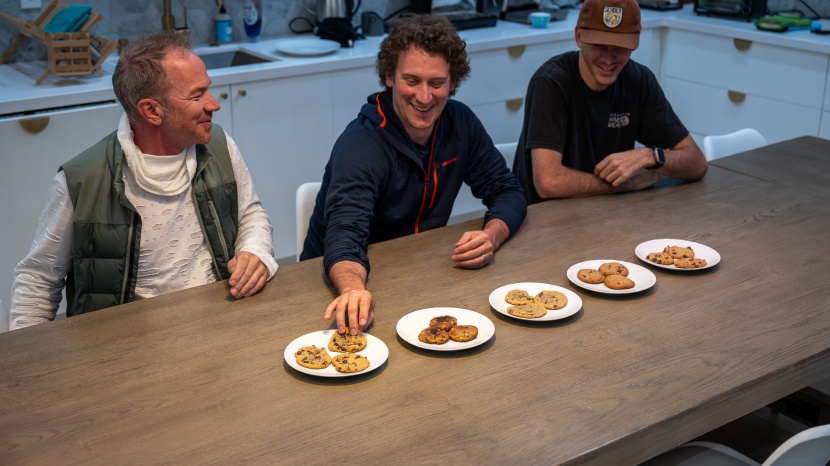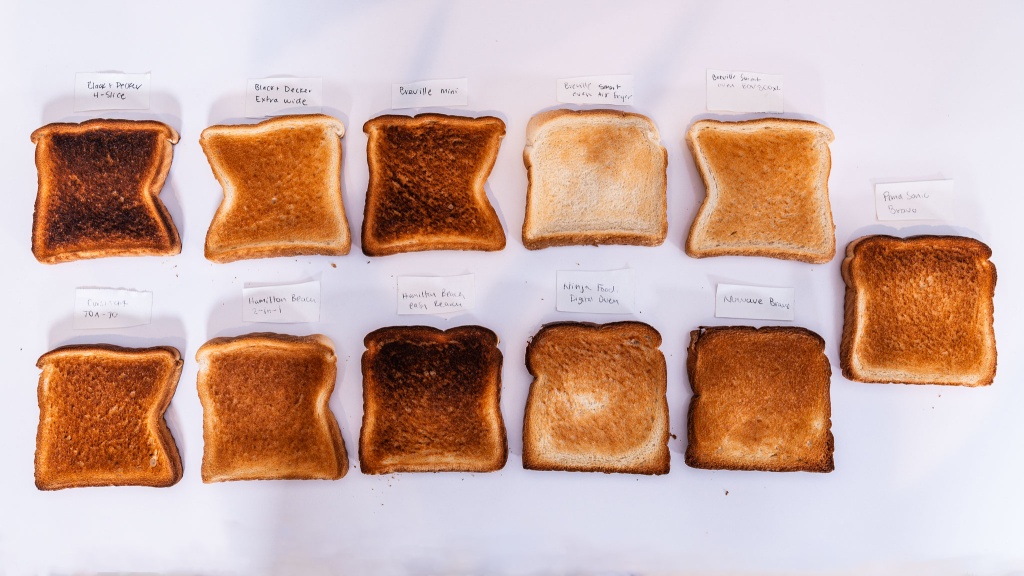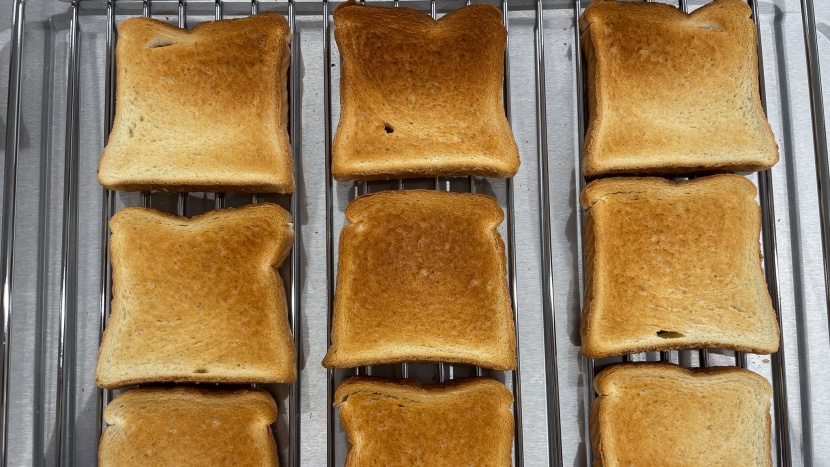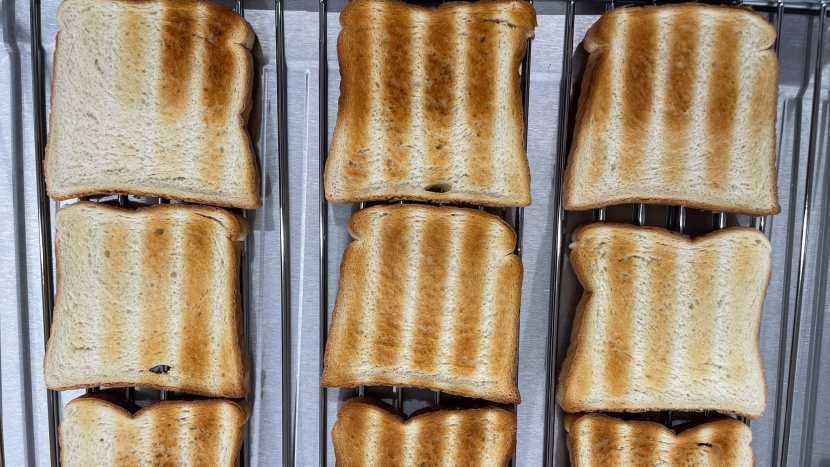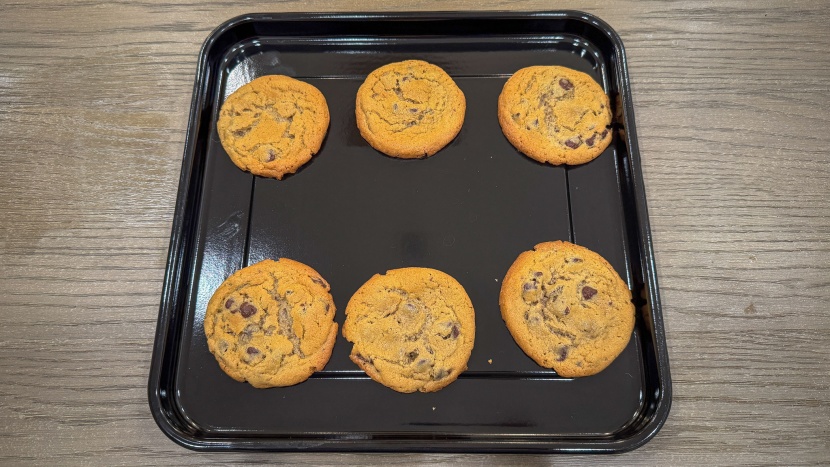Before we began testing toaster ovens, we had many lengthy discussions about what would be the best food products to use. After considering our own experiences using a variety of kitchen appliances, scouring user reviews, and asking anybody who would lend an ear, we believe we came up with a list of testing foods that covers the full gamut of things users want to make in a toaster oven.
We broke our testing down into four main metrics. Toasting Performance, Baking/Roasting Performance, and Temperature Accuracy—focus on cooking quality. Our Ease of Use metric considers how simple each model is to use and whether or not they have the propensity to induce hunger-driven temper tantrums.
Toasting Performance
A toaster oven loses a lot of versatility points if it can't make decent toast. In our testing, we made toast in each model on the medium shade setting using each oven's toast mode. We then evaluated the resulting toast for evenness and taste/texture. The ideal piece of toast would have an even level of browning across the face of the toast, and both sides of the toast would be identical. This is nearly impossible for a toaster oven to achieve because the rack inevitably leaves odd marks on the toast. However, some models were able to achieve high marks for their bread-toasting ability.
The ideal oven would have perfectly consistent heat throughout the entirety of its cooking chamber. In reality, ovens are inevitably going to lose some heat through their walls, thus the outer portions of the oven will be slightly cooler than the middle. This is not an issue for most baked goods, as they would be placed in the center of the oven anyway. However, toast is one item you might ram to capacity in a toaster oven, especially in smaller ovens, or if you're hosting a big brunch party. Each oven has a toasting sweet spot in the center, and bits around the edge where bread won't get toasted as much. To test this, we made toast maps by packing the toaster full and placing bread all the way to the edges of the toasting rack. This revealed the size of each model's toasting sweet spot and showed whether bread near the edges would be neglected.
Baking and Roasting Performance
While toasting might be the namesake function, we've found that baking and roasting capabilities often determine a toaster oven's true value in the kitchen. Our comprehensive baking tests push these compact ovens to their limits, evaluating whether they can genuinely serve as alternatives to full-size ovens for everyday cooking tasks.
Our baking battery begins with prepared cookie dough, specifically chocolate chip cookies placed on the included baking pan. After preheating each oven for 5 minutes—or following the manufacturer's preset preheat cycle when available—we bake cookies according to package directions. The ideal result features cookies with golden-brown edges, slightly crispy exteriors, and gooey centers. We found dramatic variations in performance. Top-scoring models produced bakery-quality results indistinguishable from those baked in our control full-size oven, while poor performers left us with cookies sporting burnt bottoms and raw tops, or uniformly underbaked despite following timing guidelines precisely.
Frozen pizza presents unique challenges for toaster ovens, testing their ability to crisp a bottom crust while properly melting cheese on top. We place pizzas directly on the wire rack as recommended for optimal crust crispness, following package temperatures and timing. We evaluate the final product for cheese melt quality, crust crispness, and overall even heating. The best ovens delivered pizzeria-style results with bubbling cheese and crispy crusts, while underperformers produced soggy-bottomed disappointments or unevenly melted toppings where edges burned while centers remained cold.
Our frozen tater tot test examines how well each oven circulates hot air to achieve crispy exteriors without drying out interiors. We arrange tots in a single layer on the baking pan, following package directions for conventional oven preparation. Superior models with effective convection systems produced restaurant-quality results—golden and crunchy outside, fluffy inside. Models with poor air circulation left us with tots that were either leather-tough from overcooking or disappointingly soggy despite extended cooking times.
The ultimate test of roasting prowess comes with bone-in chicken thighs. This challenging protein requires achieving crispy skin while ensuring the meat reaches safe internal temperatures without drying out. We season thighs simply with salt and pepper, then roast at 400°F, monitoring both surface browning and internal temperature. Elite performers produced professional-quality results: gorgeously bronzed, crispy skin that crackled when cut, revealing juicy, perfectly cooked meat beneath. We measured internal temperatures at multiple points to ensure even cooking throughout. Lesser models struggled with hot spots that charred skin in some areas while leaving other portions pale and rubbery, or required such extended cooking times that meat became dry and stringy despite reaching proper temperatures.
Ease of Use
Even the most capable toaster oven becomes a kitchen burden if it's frustrating to operate daily. Our ease of use evaluation examines every aspect of the user experience, from initial setup through daily operation and maintenance.
Apart from how easy it is to remove and clean the crumb tray, ease of use for toaster ovens mostly boils down to how simple it is to navigate through the plethora of functions. To assess this, we held the inaugural toaster oven Olympics in our office. Participants were given a list of many things to do on each oven, including but not limited to changing between modes before and after starting a cook cycle, adjusting temperature and time in the middle of a cook cycle, turning convention on and off, and of course, cleaning the crumb tray. All of the participants then bestowed a grade upon each model based on how easily they were able to complete all of the tasks.
Temperature Accuracy
In order to test temperature accuracy, we purchased two of the most highly regarded oven thermometers. We found that these thermometers never differed from one another by more than 5˚, so we felt confident in their accuracy. We put these thermometers in each oven, set the temperature to 350 degrees Fahrenheit, and tracked their temperatures for thirty minutes, logging the temp every six seconds and gathering thousands of data points. We repeated this test 3 times and logged the average standard temperature deviations, uncovering which toaster ovens ran hot, which ran cool, and which stayed truest to their set temps.
We also measured how long each oven took to preheat to 350F, again taking three measurements and using the average of the three. The fastest models were usually those with smaller interiors, while cavernous ovens took the longest.

